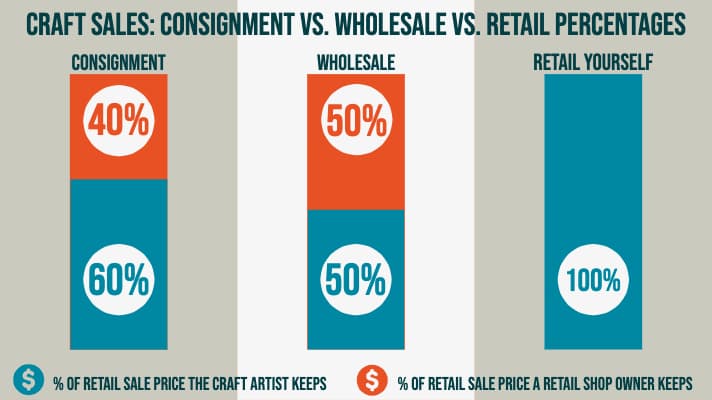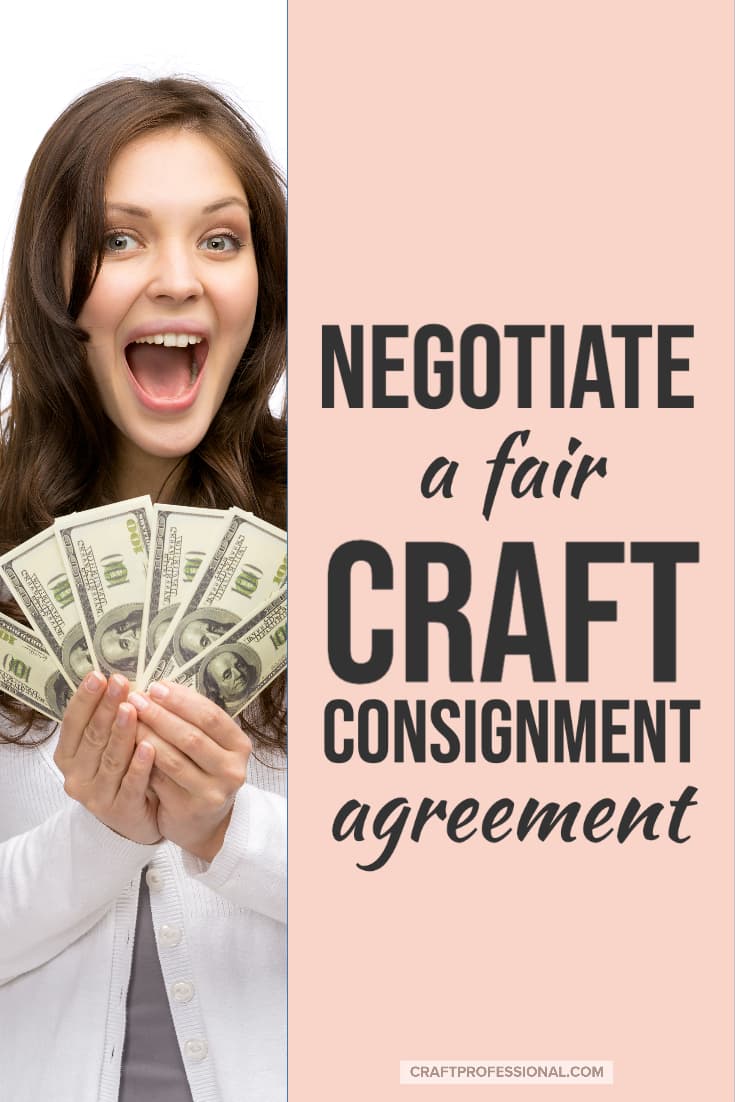What is a Fair Consignment Percentage?
What is a fair consignment percentage for craft artists? Here's the typical consignment split for retailers and craft business owners to help you negotiate a fair consignment contract. Plus understand the differences between wholesale vs. retailing yourself vs. consignment.
If you want to sell your crafts through a retailer on a consignment basis, you'll need to be ready to negotiate a fair consignment percentage.
Before any of your handmade products sell in a retailer's shop, you'll need to agree what percentage of the retail price you will keep and how much the retailer will keep.
Consignment percentages can vary, and there may be room to negotiate, but a typical consignment split is:
- 60 percent to the craft artist
- 40 percent to the retailer
I earn a commission for purchases made through links on this page.
To learn more, please see my disclosure.
Consignment Percentages vs. Wholesale and Retail Percentages
We've already established that a common craft consignment split is 60/40. Let's take a look at how much of the retail sales price you, the craft artist, get when you sell to a wholesale customer and when you retail your products yourself (at craft shows, for example).
If a retail shop owner buys your crafts on a wholesale basis, the split is typically:
- 50% to the craft artist
- 50% to the retailer
That is, the retail shop owner will typically pay you 50% of the suggested retail sales price up front. She in turn earns her 50% of the retail sales price when an item is sold in her shop.
In a wholesale arrangement, all of your expenses and profit have to come out of 50% of the retail sales price. The shop owner's expenses and profit have to come out of the other 50% of the retail sales price
When you sell your product yourself directly to retail customers, you keep 100% of the retail sales price.
There's no shop owner to split the income with since you're retailing the product yourself. You do more work and encounter more expenses retailing your product yourself, but the payoff is that you don't have to split that income with anyone.
Some online shops and a small number of craft shows charge you a percentage of the sale price when you sell your item through their venue. For example, if you sell an item on Etsy, you will be charged a transaction fee of 5% of the sales and shipping cost.
For the sake of simplicity, I'll leave those situations out of this discussion. However, do be sure to account for all of your expenses when you set your prices.
 Craft Sales: Consignment vs. wholesale vs. retail percentages
Craft Sales: Consignment vs. wholesale vs. retail percentagesLet's look at an example of an item that sells to customers for a $50 retail price.
Consignment Selling:
A retail shop owner who wanted to sell your work on consignment would agree to display some of your items in her shop. You would not be paid upfront for your product.
If a $50 item sells, you would get $30 (60% of the sale price), and the store owner would keep $20 (40% of the sale price). You don't get paid until your item sells.
I've written more about how to start consignment selling including: how to decide if selling on consignment is right for your business, approach retailers, and negotiate fair terms. Check it out!
Selling Wholesale:
A retail shop owner who wanted to buy your work wholesale would expect to pay, up front, $25 each for a large number of your items. She would sell them in her store for $50 each.
You get $25 per item when the store owner pays for the purchase of your goods. The store owner gets $25 per item when she sells it in her shop. You get paid whether your product sells for the retailer or not. However, if your items sell well, you will likely get repeat orders.
Note that paying up front in wholesale arrangements can actually mean paying within a specified time from shipping or receipt of goods. For example, your wholesale agreement might specify you will be paid in full within 30 days of delivery of the product (referred to as net 30).
Retailing Yourself:
When you retail the item yourself, you keep the full $50 retail sales price. However, you will also have expenses related to selling, like craft show booth fees, online shop fees, expenses related to promotion, labor (yours or someone else's) staffing your craft booth or managing your online shop.
Why Are There Such Big Differences in Retail vs. Wholesale vs. Consignment Percentages?
Costs to Create
In all three cases, you, the craft artist incur the costs and risks involved in creating the product. Those costs should be factored in to 50 percent of the sale price. That is, if you sell an item for a $50 retail price, half of that retail price ($25) should cover the costs of raw materials, labor, and other business expenses related to producing the product with extra built in for profit.
Costs to Sell
The differences in the three arrangements take into account the costs and risks to sell the product.
Costs to sell can include expenses such as: rent, utilities, sales staff, credit card and banking fees, craft booth fees, online shop fees, and advertising.
The other 50% of a handmade product's retail sales price accounts for the costs to sell with extra built in for profit.
When you retail the item yourself - at a craft show, for example - you incur all of the selling costs. You also take on all of the risk. Anyone who has sat through a rained-out craft show without making many sales will completely understand those risks.
When you sell your items on consignment, the shop owner incurs most of the selling costs, but they don't take on risk because they don't buy your product outright. Also, you will typically spend more time managing a consignment arrangement than you would spend managing a wholesale account. A 60/40 split in consignment is meant to account for the lower risk the retailer takes with this type of arrangement.
When you sell the item wholesale, you incur fewer selling costs. You're selling a large volume of products to a few single customers, which costs less than selling a small number of items to a lot of customers. The retail shop owner who buys your product incurs most of the selling costs and all of the risks, so the percentage you keep is lower (50%).
Summary of selling costs and risks:
- Retail yourself, and take on all of the of the selling costs and all of the risks, and you get 100% of the retail sale price.
- Sell on consignment, and keep most of the risks but limited selling costs, and you get 60% of the retail sale price.
- Sell wholesale, and keep none of the selling risks and limited selling costs, and you get 50% of the retail sale price.
Other Potential Consignment Percentages and Fees
While 60/40 is a common consignment split, you may come across other arrangements - some that work in your favor and some that work against you.
Some craft artists negotiate a 70/30 split (70% for the craft artist and 30% for the retailer).
This split, on the surface, appears more lucrative and advantageous for the craft artist. However, do keep in mind you want the retailer to be motivated to promote your product.
She needs to be receiving enough income from the sale of your products to cover her selling costs with enough profit to motivate her to promote your products over other items in her shop.
Some shops offer a 50/50 split in their consignment agreements.
I'm not a huge fan of this arrangement. 50/50 is typical of wholesale arrangements. If a retailer can get your products on consignment for a 50/50 split without taking on any of the risk involved in buying inventory wholesale, what motivation is there to wholesale?
On top of the consignment percentage, some retail shops charge a monthly fee for you to have your items in their store.
In this case, you're taking on more of the selling costs and risks. Retailers who insist on a higher than typical consignment percentage and / or monthly shop fees make it quite tough for the craft artist to make a reasonable profit.
In my own opinion, a 60/40 split is a fair consignment percentage under most circumstances. The shop would need to be something truly special - well-established, prestigious, with a customer base that's a great fit, and an owner you can work with - to consider a consignment agreement in which you earned less than that.



New! Comments
Have your say about what you just read! Leave me a comment in the box below.